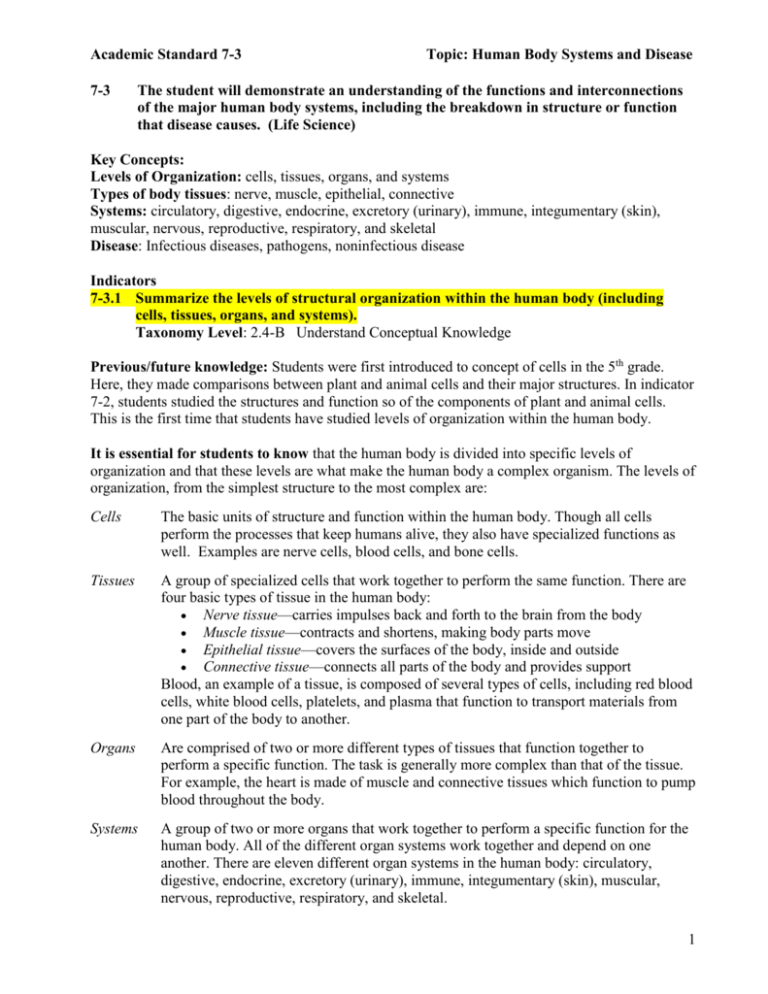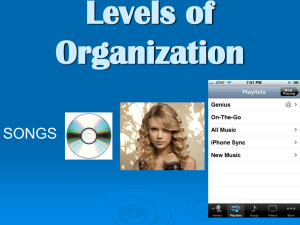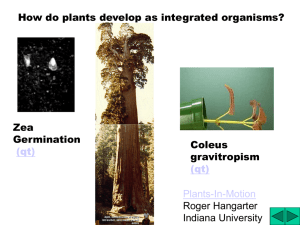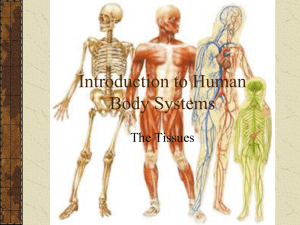7-3 Human Body & Diseases
advertisement

Academic Standard 7-3 7-3 Topic: Human Body Systems and Disease The student will demonstrate an understanding of the functions and interconnections of the major human body systems, including the breakdown in structure or function that disease causes. (Life Science) Key Concepts: Levels of Organization: cells, tissues, organs, and systems Types of body tissues: nerve, muscle, epithelial, connective Systems: circulatory, digestive, endocrine, excretory (urinary), immune, integumentary (skin), muscular, nervous, reproductive, respiratory, and skeletal Disease: Infectious diseases, pathogens, noninfectious disease Indicators 7-3.1 Summarize the levels of structural organization within the human body (including cells, tissues, organs, and systems). Taxonomy Level: 2.4-B Understand Conceptual Knowledge Previous/future knowledge: Students were first introduced to concept of cells in the 5th grade. Here, they made comparisons between plant and animal cells and their major structures. In indicator 7-2, students studied the structures and function so of the components of plant and animal cells. This is the first time that students have studied levels of organization within the human body. It is essential for students to know that the human body is divided into specific levels of organization and that these levels are what make the human body a complex organism. The levels of organization, from the simplest structure to the most complex are: Cells The basic units of structure and function within the human body. Though all cells perform the processes that keep humans alive, they also have specialized functions as well. Examples are nerve cells, blood cells, and bone cells. Tissues A group of specialized cells that work together to perform the same function. There are four basic types of tissue in the human body: Nerve tissue—carries impulses back and forth to the brain from the body Muscle tissue—contracts and shortens, making body parts move Epithelial tissue—covers the surfaces of the body, inside and outside Connective tissue—connects all parts of the body and provides support Blood, an example of a tissue, is composed of several types of cells, including red blood cells, white blood cells, platelets, and plasma that function to transport materials from one part of the body to another. Organs Are comprised of two or more different types of tissues that function together to perform a specific function. The task is generally more complex than that of the tissue. For example, the heart is made of muscle and connective tissues which function to pump blood throughout the body. Systems A group of two or more organs that work together to perform a specific function for the human body. All of the different organ systems work together and depend on one another. There are eleven different organ systems in the human body: circulatory, digestive, endocrine, excretory (urinary), immune, integumentary (skin), muscular, nervous, reproductive, respiratory, and skeletal. 1 Academic Standard 7-3 Topic: Human Body Systems and Disease It is not essential for students to know the major tenets of the cell theory or explain the process of cell differentiation as the basis for the hierarchical organization of organisms as these concepts will be further developed in high school biology. Assessment Guidelines: The objective of this indicator is to summarize the levels of organization of organisms; therefore, the primary focus of assessment should be to generalize the different levels of organization. However, appropriate assessments should also require student to identify the individual levels; illustrate the levels using words, pictures, or diagrams; or classify by sequencing the levels of organization. 2 Academic Standard 7-3 Topic: Human Body Systems and Disease 7-3.2 Recall the major organs of the human body and their function within their particular body system. Taxonomy Level: 1.2-A,B Remember Factual and Conceptual Knowledge Previous/future knowledge: This is the first time in science that students have been introduced to the human body and its functions. In kindergarten and 4th grade, students identified and explained distinct structures associated with the five senses only. Students will not develop this concept further in high school biology because the focus will be at the cellular level. It is essential for students to know the major organs of the human body and be able to list their functions within their identified body system. The major organs and their functions that students should be able to identify are: System Circulatory Major Organs Heart Respiratory Blood vessels (arteries, capillaries and veins) Nose Trachea Bronchi Diaphragm Digestive Mouth Esophagus Stomach Small intestines Large intestines Rectum and anus Function (s) Causes blood to flow through the body by it pumping action Tubes that carry blood throughout the entire body Collects air from the environment and moistens and heats the air before it enters the trachea The windpipe; moves air from the nose to the lungs Tubes that move air from the trachea to the lungs; one bronchus leads to each lung; part of each bronchus is outside the lung and part is inside. The dome-shaped muscle that aides in the breathing process Begins to break down food into smaller pieces through mechanical digestion; saliva in the mouth starts the process of chemical digestion The transport tube that carries chewed food to the stomach Continues the process of mechanical digestion; secretes enzymes that perform some chemical digestion of food The organ where most of the chemical digestion of food takes place; nutrients from food are also absorbed through the small intestines The organ where water is absorbed from the food and taken into the bloodstream; prepares the remaining food material for elimination from the body The rectum is a short tube that stores solid waste until it is eliminated from the body through the anus. 3 Academic Standard 7-3 System Digestive continued Major Organs Liver Pancreas Gallbladder Excretory (Urinary) Kidneys Ureters Bladder Urethra Nervous Brain Spinal cord Peripheral nerves Muscular Skeletal muscles Smooth muscles Skeletal Cardiac muscles Bones Topic: Human Body Systems and Disease Function (s) An ancillary organ of the digestive system that produces bile which is used by the body to break up fat particles. An ancillary organ to the digestive system that functions to produce enzymes that help break down starches, proteins, and fats in the small intestine. An ancillary organ to the digestive system that functions to store bile produced by the liver. The two kidneys function to get rid of urea , excess water, and some other waste materials which are eliminated in urine Tubes which connect each kidney to the bladder A saclike muscular organ which stores urine until it is released from the body Tube through which urine passes before it is removed from the body. An organ of the central nervous system which has three distinct parts that all serve to control and coordinate the body’s activities. The cerebrum controls thoughts, voluntary actions, and the sensations related to the five senses. The cerebellum helps with balance and coordination. The brain stem is located at the base of the brain and controls vital and involuntary processes, for example, breathing, the beating of the heart, and digestion. A bundle of nerves that begins at the brain stem and continues down the center of the back. It connects with nerves outside the central nervous system and controls reflexes and directs sensations to the brain. A network of nerves that branch out from the spinal cord and connect to the rest of the body. The peripheral nervous system is divided into groups called the motor and sensory nervous systems. Voluntary muscles that are attached to bones and provide the force needed to move your bones Involuntary muscles that control many types of movement in the body (i.e, digestion) Involuntary muscle that forms the heart Provide shape and support for the body and protection for many organs and structures; some bones produce blood cells; some store minerals 4 Academic Standard 7-3 System Major Organs Integumentary Skin Topic: Human Body Systems and Disease Function (s) Covers the body and prevents the loss of water; it protects the body from infection and injury; it helps to regulate body temperature, get rid of wastes (sweat), receive information from the environment and produce vitamin D. It is not essential for students to know the major organs of the reproductive system, immune system, endocrine system. These systems will be studied in Health. Assessment Guidelines: The objective of this indicator is to recall; therefore, the primary focus of assessment should be to identify the different organs and describe their major functions. However, appropriate assessments should also require student to identify the system that each organ belongs to; recognize an organ or system from words, pictures, or diagrams; identify an organ based on the description of its function. 5 Academic Standard 7-3 Topic: Human Body Systems and Disease 7-3.3 Summarize the relationships of the major body systems (including the circulatory, respiratory, digestive, excretory, nervous, muscular, and skeletal systems). Taxonomy Level: 2.4-B Understand Conceptual Knowledge Previous/future knowledge: This is the first time in science that students have been introduced to the concept of the relationships between the major body systems. Students will not develop this concept further in high school biology, as the primary focus in that course will be at the cellular level. It is essential for students to know that the different organs systems in the human body function together and depend on one another for the human body to function successfully, even though each system performs its own unique function. Of the eleven systems in the body, students should know how the following systems work together: Nervous System The main role of the nervous system is to relay electrical signals through the body. The nervous system directs behavior and movement and, along with the endocrine system, controls physiological processes, for example digestion, circulation, or movement. The body cells need oxygen to function. Taking in oxygen and transporting it to cells are the jobs of the respiratory and circulator systems. Circulatory System The main role of the circulatory system is to transport nutrients, gases (for example oxygen and carbon dioxide), hormones, and wastes through the body. Respiratory System The main role of the respiratory system is to provide gas exchange between the blood and the environment. Primarily, oxygen is absorbed from the atmosphere into the body and carbon dioxide is expelled from the body. The circulatory and digestive systems work together to ensure that nutrients made available by digestion get to the cells of the body. The digestive and excretory systems work together to take in materials your body needs and gets rid of wastes. Digestive System The main roles of the digestive system are to breakdown and absorb nutrients that are necessary for growth and maintenance. Excretory System The main role of the excretory system is to filter out cellular wastes, toxins and excess water or nutrients from the circulatory system. The muscular and skeletal systems work together to help the body move. Muscular System The main role of the muscular system is to provide movement. Muscles work in pairs to move limbs and provide the organism with mobility. Muscles also control the movement of materials through some organs, for example the stomach and intestine, and the heart and circulatory system. Skeletal System The main role of the skeletal system is to provide support for the body, to protect delicate internal organs and to provide attachment sites for the organs. 6 Academic Standard 7-3 Topic: Human Body Systems and Disease It is not essential for students to know the functions of the reproductive system, immune system, endocrine system, or integumentary system. These systems will be studied in Health. It is also not essential for students to know the chemical processes within each system. Assessment Guidelines: The objective of this indicator is to summarize the relationships between major body systems; therefore, the primary focus of assessment should be to generalize the major points about how the different systems work together. However, appropriate assessments should also require student to interpret a diagram or illustration of interacting body systems; or to identify the function of the individual systems identified. 7 Academic Standard 7-3 Topic: Human Body Systems and Disease 7-3.4 Explain the effects of disease on the major organs and body systems (including infectious diseases such as colds and flu, AIDS, and athlete’s foot and noninfectious diseases such as diabetes, Parkinson’s, and skin cancer). Taxonomy Level: 2.7-B Understand Conceptual Knowledge Previous/future knowledge: This is the first time in science that students have been introduced to the concept of disease relating to the human body. In 6th grade, students studied the effect of disease-causing fungi on plants. Students will study the detection and treatment of some common communicable and chronic diseases and how disease processes affect the body systems in health, but students will not develop this concept further in high school biology as the focus of that course of study will be at the cellular level. It is essential for students to know that a disease is a condition that does not allow the body to function normally. Diseases can affect either an individual organ or an entire body system. Diseases are divided into two groups—infectious and noninfectious. Tiny organisms called pathogens cause infectious diseases. These pathogens can be bacteria, viruses, fungi, or protists. These pathogens can come from another person, a contaminated object, an animal bite, or the environment. The immune system is responsible for distinguishing between the different kinds of pathogens and reacting to each according to its type. Once a pathogen enters has entered the body, it works by damaging individual cells within the organs or in some cases attacks an entire body system. Some examples that students should know are: Colds A common cold is an illness caused by a virus infection located in the respiratory system. Cold viruses can only reproduce when they are inside living cells. When located on an environmental surface (for example a doorknob or drinking glass), cold viruses cannot reproduce. However, they are still infectious and can be transported from the environmental surface to the nose or mouth. Flu (Influenza) Strep throat Influenza, commonly known as "the flu," is a highly contagious viral infection of the respiratory system. Influenza typically causes fever, muscle aches, and a more severe cough than the common cold and usually last longer. (bacterial) Athlete’s foot Athlete’s foot is a common fungal infection of the skin of the feet. The fungus is contracted from public environments and then grows in the warm and moist environment usually between the toes, and can be difficult to get rid of. AIDS Acquired immunodeficiency syndrome (AIDS) is caused by the human immunodeficiency virus (HIV). This virus attacks the cells in the immune system making the organism unable to fight off other pathogens that may attack the body. NOTE: Caution should be taken when discussing AIDS with students. Follow guidelines as prescribed by the Health curriculum. 8 Academic Standard 7-3 Topic: Human Body Systems and Disease Noninfectious diseases are diseases that are not caused by pathogens in the body and are not spread from organism to organism. These diseases are either caused by cardiovascular disease, allergies, diabetes, and cancer are examples of noninfectious diseases. Some noninfectious diseases that students should know are: Diabetes Diabetes is a disease that results in the glucose, or sugar, level of the blood being higher than the normal range. It is caused by a person’s inability to either produce or use properly a natural chemical produced in the body called insulin. The higher level of blood sugar results many disorders of the body, for example it increases problems with circulation of blood, and it can lead to kidney disease and heart disease, or cause vision problems. Asthma (Involves the respiratory system) Parkinson’s disease Parkinson's disease occurs when certain nerve cells in the brain die or become damaged. Parkinson's disease does not affect everyone the same way. In some people the disease develops quickly, in others it does not. Although some people become severely disabled, others experience only minor motor disruptions. Tremor is the major symptom for some people, while for others tremor is only a minor complaint and different symptoms are more troublesome. At present, there is no cure for Parkinson's disease. Skin Cancer Skin cancer is a disease in which cancer cells are found in the outer layers of your skin. Your skin protects your body against heat, light, infection, and injury. It also stores water, fat, and vitamin D. Sunburn and UV light can damage your skin, and this damage can lead to skin cancer. However, there are other determining factors, including heredity and the environment. It is not essential for students to know how the immune system specifically responds to different pathogens (for example T-cells and B cells) or to go into depth regarding other diseases of the human body. Assessment Guidelines: The primary focus of this indicator is to explain the effect of diseases; therefore, the primary focus of assessment should be to construct cause and effect models of how the disease affects the organs and systems. However, appropriate assessments should also require students to classify the identified diseases as infectious or noninfectious; identify which organ or system the disease affects; summarize the characteristics of a particular disease; or identify the common causes of infectious diseases. 9 Academic Standard 7-3 Topic: Human Body Systems and Disease Supporting Web Sites National Center for Infectious Diseases www.cdc.gov/NCIDOD This web site allows students to study various infectious diseases which attack the human body. It also allows students to research emerging infectious diseases. 7-3.4 Body Quest http://library.thinkquest.org/5777/dig1.htm This site permits students to explore the anatomy of the various organs and systems of the human body. 7-3.2 Human Anatomy on Line http://www.innerbody.com/htm/body.html At this site students can explore the various systems of the human body. It also contains animations of how the organs within a system work together to perform specific functions. 7-3.2 and 7-3.3 The Human Body http://www.medtropolis.com/VBody.asp Site which provides students with virtual diagrams of various organs and systems in the human body. 7-3.2 Basic Anatomy-Tissues and Organs http://web.jjay.cuny.edu/~acarpi/NSC/14-anatomy.htm General description of relationship between tissues and organs. Diagrams are provided for the students. 7-3.1 BUPA www.bupa.co.uk/health_information/html/organ/ Excellent site which shows relationship between organs and systems of the human body. Good graphics are found at this site. 7-3.2 Infectious Diseases and Their Treatments www.schoolscience.co.uk/content/4/biology/abpil/diseases.index.html Presentation on diseases caused by bacteria, fungi, viruses and protozoa. 7-3.2 10 Academic Standard 7-3 Topic: Human Body Systems and Disease DMOZ http://dmoz.org/Kids_and_Teens/School_Time/Science underscore after Kids, and, and School; go to Living Things, then Humans This site provides links between various systems (circulatory, nervous, and skeletal) and infectious and non-infectious diseases. 7-3.3 and 7-3.4 National Library of Medicine www.nlm.nih.gov This site provides information about infectious and non-infectious disease ( systems, causes, treatments, etc.) Perhaps the most complete information available. 7-3.4 Suggested Literature Ford, Michael Thomas. The Voices of AIDS. Morrow (1996) IBSN:0-688.05322 Lexile Level 1010L Personal stories about HIV/AIDS and how the disease affected young people’s lives. This book is appropriate for middles school students and higher. 7-3.4 Sanderman, Anna. Bones. Millbrook (1996) ISBN 1-56294-621-8 Students can learn about the relationships between the human skeleton, joints and muscles. 7-3.3 Burnie, David. The Concise Encyclopedia of the Human Body. DK Publishing (1996) ISBN:0-7894-0204-1 Excellent reference guide to student questions about the human body. This guide also includes tables of infectious and non-infectious diseases. 7-3.2, 7-3.3, and 7-3.4 Sanderman, Anna. Blood. Copper Beach/Millbrook (1997) ISBN: 0-761-0477-0 This book explains the relationship between the heart, lungs, and blood vessels. It also answers questions of “how” and “why” that students ask about the circulatory system. Simon, Segmore. The Brain: Our Nervous System. Murrow Junion Books (1998) ISBN:0-688-14641-4 This book takes students on a tour of the brain and the processes that occur there. It also explains the relationships between the nerve cells, axons, and synapse regions. 7-3.2 11 Academic Standard 7-3 Topic: Human Body Systems and Disease McPherson, Stephanie S. Jonas Salk: Conquering Polio. Lerner Publications (2001). ISBN:0-8225-4964-6 This book describes the research of Dr. Jonas Salk in finally producing a vaccine to prevent the dreaded disease polio. It explains how he was dependent on existing research and how new technology enabled him to produce his vaccine. Walker, Richard. DK Guide to the Human Body. DK Publishing (2001) Trade ISBN:0-7894-7388-7 This book take the student on a view of the human body from the microscope to the macroscopic level through the use of x-rays, and MRI and CT scans. These images are helpful in explaining the functions of the human body. 7-3.1 and 7-3.3 Davidson, Sue and Morgan, Ben. Human Body Revealed. DK Publishing. (2003). Trade ISBN: 0-7894-8882-5 High quality and quantity of images of the human body. Reader is able to “peel away” layers, showing the interactions among the body systems. 7-3.3 Kowalski, Kathiann M. . Attack of the Super Bugs: The Crisis of Drug-Resistant Diseases. Enslow Publishers. Library ISBN:0-7660-2400-8 This book describes the rise of the super bug (bacteria) which are becoming resistant drugs which have been used to fight certain diseases. Case studies are presented concerning research being done on these “super bugs”. 7-3.4 Silverstein, Alvine and Virginia and Nunn, Laura S. . Cancer. Twenty-First Century Books/Lerner Publishing Group. (2005). Library ISBN:0-7613-2833-5 Different types of cancer are explained in this book. It also describes how these cancers are found and treated. 7-3.4 Suggested Streamline Video Greatest Discoveries with Bill Nye: Medicine This video covers many areas of Life Science including early studies in anatomy. It focuses primarily on infectious diseases and cancer. ETV Streamline SC Birth of Anatomy (3:41) Blood Circulation (2:08) Germ Theory (4:38) Vaccination (3:01) Genetic Basis of Cancer (4:52) HIV (05:37) 7-3.4 12 Academic Standard 7-3 Topic: Human Body Systems and Disease Inside Story: Your Body Your Health ETV Streamline SC Good video that covers the infectious diseases (HIV) Infectious Preventing and Treating AIDS (6:14) 7-3.4 The Musculoskeletal System ETV Streamline SC This video shows the relationship between the muscular system and the skeletal system. (24:30) 7-3.1 The Ultimate Guide: Human Body ETV Streamline SC This video shows how various parts of the human body work together. Part I (24:30) Part II (23:40) 7-3.5 Human Body Systems: The Circulatory System ETV Streamline SC This video describes the parts which make-up the circulatory system and their functions. 3-D graphics enhance the viewing of this video. (23:00) 7-3.2 and 7-3.3 Human Body Systems: The Respiratory System ETV Streamline SC Various components of the Respiratory System are described and how they function together in the human body. (21:00) 7-3.2 and 7-3.3 Human Body Systems: The Digestive System ETV Streamline SC Follow a particle of food from the mouth all the way through the entire digestive system. The breakdown of food is explained in each part of the system. (20:00) 7-3.2 and 7-3.3 Human Body Systems: The Excretory System ETV Streamline SC Explanation and examination of the organs that make up the excretory system (17:00) 7-3.2 and 7-3.3 Basics of Biology, The Human Body: Organ Systems Working Together ETV Streamline SC Animations show the functions of the various organ systems and how they work together. (14:39) 7-3.1 13 Academic Standard 7-3 Topic: Human Body Systems and Disease Human Body Systems: The Nervous System ETV Streamline SC Describes the brain, spinal cord and nerves. Explains how these organs and tissues work together to transmit electrical impulses. (14:39) -12 segments 7-3.2 and 7-3.3 Careers Connections Cardiovascular Technologist. These individuals conduct tests on pulmonary or cardiovascular systems for patients for diagnostic purposes. They may conduct electrocardiograms, cardiac catheterizations, pulmonary-functions and similar tests. An associate degree is necessary in this field. 7-3.2 and 7-3.3 Biomedical Engineer. These individuals apply knowledge of engineering and biology to the design and development of biological products such as artificial organs, prostheses, etc. A bachelors degree is necessary for this field. 7-3.2 and 7-3.3 Biophysicist. Individuals in this occupation research physical principles of living cells and organisms, their electrical and mechanical energy and related phenomena. A bachelors degree and beyond are required for persons entering this field. 7-3.1 Forensic Science Technicians. A popular field today because of many TV programs. They investigate crimes by collecting and analyzing physical evidence. Knowledge of the human body is necessary for this profession. An associate degree is necessary. 7.31 , 7-3.2, 7-3.3 and 7-3.4 Biotechnologist/Genetic Engineer. These scientists use technology to manipulate genetic material of living organism. Many are involved in changing DNA to combat many diseases (particularly non-infectious diseases). A bachelors degree is necessary. 7-3.4 14









